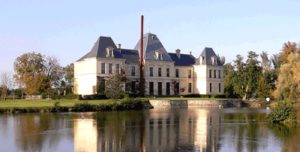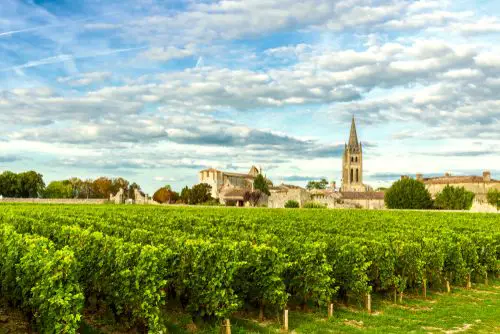 Chateau d’Arsac has risen like a phoenix from the ashes thanks to the dynamism of its owner, Philippe Raoux, and is a great example of how a once neglected estate can be reborn.
Chateau d’Arsac has risen like a phoenix from the ashes thanks to the dynamism of its owner, Philippe Raoux, and is a great example of how a once neglected estate can be reborn.
This chateau had long been an oddity in Bordeaux as the wheel of fortune seemed to have passed it by in modern times. After the phylloxera crisis at the turn of the 20th century not a single vine remained at d’Arsac and in the mid 1930′s the chateau was completely abandoned.
Unbelievably, the chateau’s actual winery became a chicken-coop from the end of the Second World War to the mid 1980’s. Such was its condition that d’Arsac was not even considered for the M argaux appellation, which was created in 1954. Every other chateaux in the commune of Arsac was entitled to bear the Margaux AOC on their wines except it’s namesake.
argaux appellation, which was created in 1954. Every other chateaux in the commune of Arsac was entitled to bear the Margaux AOC on their wines except it’s namesake.
It was a strange state of affairs as Chateau d’Arsac has a glorious past. It is regarded as one of the oldest wine estates in the Medoc and has a rich history that can be traced back over 900 years.
Records go back to the time of Eleanor of Aquitaine (1122 – 1204). During the Hundred Years War (1337 – 1453) the Lords of Arsac were allies with the  King of England. In the 16th century, the estate was acquired by Thomas de Montaigne, the brother of the famous philosopher, Michel de Montaigne.
King of England. In the 16th century, the estate was acquired by Thomas de Montaigne, the brother of the famous philosopher, Michel de Montaigne.
D’Arsac was also part of the Segur empire (the owners of First Growth Chateau Lafite). During the French revolution the chateau was destroyed but it was rebuilt in 1830 by the Rubichon family. By the end of the 19th century, d’Arsac’s vineyard was one of the largest in the Médoc.
D’Arsac was bought by Philippe Raoux in 1986, a 4th generation member of a family of wine makers and traders who operate the Chamvermeil wine trade business.
 Raoux vigorously embarked on reawakening Chateau d’Arsac: he reconstructed the 276 acres (112 hectares) of d’Arsac’s vineyard and after 10 years of intense renovations and investments Raoux successfully approached the INAO to have d’Arsac re qualified into the Margaux appellation.
Raoux vigorously embarked on reawakening Chateau d’Arsac: he reconstructed the 276 acres (112 hectares) of d’Arsac’s vineyard and after 10 years of intense renovations and investments Raoux successfully approached the INAO to have d’Arsac re qualified into the Margaux appellation.
It wasn’t an easy battle – experts from the INAO insisted that Chateau d’Arsac did not qualify but Raoux produced geological surveys and historical documents attesting to the quality of Chateau d’Arsac’s wine in the 19th century. And won. So, since 1995, 133 acres (54 hectares) of d’Arsac’s vineyard are classified under the AOC Margaux, the remainder are classified under the AOC Haut-Médoc.
 In 2007 Rauox opened La Winery, a 64 acre wine tourism complex in Arsac which boasts exhibition areas, park and picnic land with water features, an amphitheatre for concerts, restaurant, a tapas bar, tasting rooms and 10,000 square metres of retail space.
In 2007 Rauox opened La Winery, a 64 acre wine tourism complex in Arsac which boasts exhibition areas, park and picnic land with water features, an amphitheatre for concerts, restaurant, a tapas bar, tasting rooms and 10,000 square metres of retail space.
He has also innovated in the cellar – since 2005 a guest winemaker is invited by Raoux to create a signature wine under The Winemakers Collection. Assisted by Château d’Arsac’s wine making team, the guest winemaker is attributed full freedom to create their dream wine: from the choice of plots to selecting different vine-growing and wine-making techniques.
The winemakers involved form n impressive list: Michel Rolland, Denis Dubourdieu, Andrea Franchetti, Stéphane Derenoncourt, Eric Boissenot, Zelma Long and Susana Balbo.
 Each winemaker worked 10 hectares to produce some 30,000 bottles for each particular vintage. Raoux says that the results are amazing and that it’s like asking different audiences across the world to interpret the same music. The personality of each winemaker can be seen in each vintage when they are compared.
Each winemaker worked 10 hectares to produce some 30,000 bottles for each particular vintage. Raoux says that the results are amazing and that it’s like asking different audiences across the world to interpret the same music. The personality of each winemaker can be seen in each vintage when they are compared.
 This year Raoux has invited the Zulu winemaker Ntsiki Biyela from South Africa to produce the eighth vintage. Ntsiki Biyela was born and raised in Kwa-Zulu Natal and was the country’s first black female winemaker when she started out.
This year Raoux has invited the Zulu winemaker Ntsiki Biyela from South Africa to produce the eighth vintage. Ntsiki Biyela was born and raised in Kwa-Zulu Natal and was the country’s first black female winemaker when she started out.
Since then she has established herself as an award-winning vintner. and is now resident winemaker at Stellekaya Wines. In 2009, she was named South Africa’s Woman Winemaker of the Year.
It’s fantastic to see the rise of Chateau d’Arsac from the ashes and the driving forces of renewal breathing new life into this lovely old estate.


